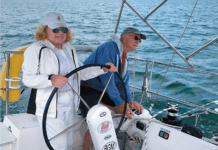For those of you who don’t remember Viva, the 1975 Tartan 44 test boat we sold last year because she was taking too much time and cruising plans werent materializing fast enough, or the C&C 33 before her, or the Pearson Vanguard before her, ad infiboatum, my life in boats seems like one big project after another. Thats fine if one day you cast off and go somewhere, like my wife and I did back in the mid-80s. Since then, however, our cruising has been limited to weekends and summer vacations. Thats fine, too, so long as maintenance and spring upgrades don’t get out of hand. They did.
The upshot is that my next boat will be smaller and simpler than an ex-ocean racer. Ive been considering lots of different types of boats, from motorsailers to catamarans to you name it. Early on, an old Sea Sprite caught my eye, mainly because its parked right next to my office.
The 22-1/2′ Sea Sprite was one of Carl Albergs earliest and most successful designs. While researching my book about fiberglass boatbuilding, Heart of Glass, I figured out some of the Sea Sprites genealogy.
The first builder was American Boatbuilding, in East Greenwich, Rhode Island, the short-lived outfit better known for the Block Island 40. Production ran from about 1959-1963. The molds were turned over to another Rhode Island builder, Sailstar, which resumed production in 1964. This coincides with Clint Pearson leaving Pearson Yachts and buying Sailstar, which he moved to Bristol. Later the Sea Sprite was built by Clark Ryder and the Sea Sprite Co.
Two versions of the Sea Sprite were offered in 1965-the four-berth cruiser at $4,395 and the rare two-berth daysailer at $3,295, of which the one outside my office was a decent example.
This boat was full of water; with no self-draining cockpit, all the water had filled the bilge and flooded the cabin. Berth cushions were sodden. The wooden bulkhead separating the cockpit from cabin was punky. Mercifully, the deck was solid glass. Out of pity (and a slight self-interest), I pumped her out and bought a cheap blue poly cover. If I was going to buy her, I thought, a little damage control now would pay dividends later.
All winter I studied her lovely lines. Why not? I goaded myself. Shed make a good bay boat, what with her full keel and large cockpit. And there was space below for a small toilet, and two berths for naps or an overnight. I even tolerated her name-Doubloon.
Then Id climb the ladder and again look inside. The wooden cockpit seats were broken and falling over. There was play in the rudderstock. Realistically, the boat needed to be gutted. In the end, I couldnt do it to myself.
Fortunately, one of our neighbors in the yard, Mike Kerr of Kiwi Marine Services, worked a deal and landed her. He set about Doubloon with a vengeance, sanding the bottom to gelcoat, removing the vinyl rubrail, and ripping everything out of the cockpit and cabin.
Mike complains about grinding the interior on a hot July day, sweating inside a paper suit. You get that fiberglass in your skin and its something awful, he groans. He says he might get sailing before the end of the season.
I know that story line. It could have been me.
-Dan Spurr






































